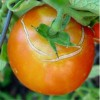Abstract
Postharvest decay losses for field-grown, fresh-market tomatoes are usually associated with harvests that occur when fields are wet and warm. During periods of persistently wet fields, decay pathogens infect damaged fruit on the plant as well as injuries to petioles and stems. Review of all reports and photos implicated excessive water in fruit rather than air temperatures as the primary predisposition. Excessive water in fruit is possible at virtually any time of the season and can appear at times of cold as well as warm field temperatures. This 8-page fact sheet was written by Jerry A. Bartz, Steven A. Sargent, and John W. Scott, and published by the UF Department of Plant Pathology, July 2012.
References
Bakker, J. C. 1988. "Russeting (Cuticle Cracking) in Glasshouse Tomatoes in Relation to Fruit Growth." J. Hort. Sci. 63 (3): 459-463. https://doi.org/10.1080/14620316.1988.11515879
Bartz, J. A., G. Karuiki, and S. A. Jordan. 2009. "Green Tomato Fruits are Predisposed to Sour Rot when Congested with Water." Phytopathology 99 (6): S8.
Bartz, J. A., M. A. Ritenour, and M. Elkahky. 2010. "Chilling Injury in Tomatoes Exposed to Low Temperatures in the Field." Phytopathology 100 (6): S12.
Butler, E. E. 1960. "Pathogenicity and Taxonomy of Geotrichum candidum." Phytopathology 50: 665-672.
Den Outer, R. W., and W. L. H. Van Veenendaal. 1988. "Gold Speckles and Crystals in Tomato Fruits (Lycopersicon esculentum Mill.)" J. Hort. Sci. 63 (4): 645-649. https://doi.org/10.1080/14620316.1988.11515906
Dorais, M., D-A. Demers, A. P. Papadopoulus, and W. Van Ieperen. 2004. "Greenhouse Tomato Fruit Cuticle Cracking." Hort. Rev. 30: 163-184. https://doi.org/10.1002/9780470650837.ch5
Emmons, C. L. W., and J. W. Scott. 1997. "Environmental and Physiological Effects on Cuticle Cracking in Tomato." J. Amer. Soc. Hort. Sci. 122 (6): 797-801. https://doi.org/10.21273/JASHS.122.6.797
Johnson, J. 1947. Water-Congestion in Plants in Relation to Disease. Res. Bull. 160. Madison: University of Wisconsin.
McColloch, L. P. 1955. "Effect of Low Field Temperatures on Quality of Tomatoes." Proc. Fla. State Hort. Soc. 68: 188-192.
McColloch, L. P., H. T. Cook, and W. R. Wright. 1968. "Market Diseases of Tomatoes, Peppers, and Eggplants." In USDA Agriculture Handbook (No. 28). Washington, DC: U.S. Department of Agriculture.
Moretti, C. L., S. A. Sargent, D. J. Huber, A. G. Calbo, and R. Puschmann. 1998. "Chemical Composition and Physical Properties of Pericarp, Locule, and Placental Tissues of Tomatoes with Internal Bruising." J. Amer. Hort. Sci. 123 (4): 656-660. https://doi.org/10.21273/JASHS.123.4.656
Peet, M. M. 2009. "Physiological Disorders in Tomato Fruit Development." Acta Hort. (ISHS) 821: 151-160. https://doi.org/10.17660/ActaHortic.2009.821.16

